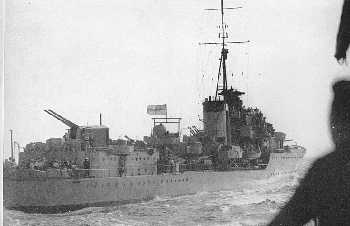- Author
- Wright, Ken
- Subjects
- Ship histories and stories, WWII operations, History - WW2
- Tags
-
- RAN Ships
- None noted.
- Publication
- March 2006 edition of the Naval Historical Review (all rights reserved)
2 April 1937
Kelly began her life as Job number 615 at the R. & W. Hawthorn/Leslie & Company Limited shipyard at Hebburn-on-Tyne, Newcastle. She and her sister ship 614 (later named Jervis) were to be built to a radical and innovative new design by the Naval Architect, A.P. Cole. Lord Louis Mountbatten, a frequent visitor to the shipyard, contributed ideas to the design based on his many years experience at sea. The two destroyers were to be Flotilla leaders and help fill the gap in the British destroyer strength. The men at the Hebburn shipyard worked hard to ensure these two ships would be their finest effort.
25 October 1938
Job 615 was christened HMS Kelly after the Admiral of the Fleet, John Kelly, and in the spring of 1939, Lord Mountbatten became her Captain and took command of 5 Destroyer Flotilla (K class) made up of the destroyers Kelvin, Kashmir, Khartoum, Kingston, Kipling, Kimberley and Kandahar.
3 September 1939
The British destroyer HMS Kelly was at sea undergoing her shakedown trials when her Captain, Lord Louis Mountbatten, was handed an urgent message. It read; ‘From Admiralty. To all concerned at home and abroad. Most immediate. Commence hostilities at once with Germany.’ The brand new destroyer was now officially at war.

The next day, Kelly, with the destroyer HMS Acheron and an anti-submarine vessel, left from Portland harbour on an early morning training exercise. They hadn’t been at sea long when suddenly the anti-submarine boat frantically signalled Kelly, ‘torpedo approaching you.’ Kelly took immediate evasive action and the torpedo missed. All three ships began a search of the area. Their war had begun to get serious. Kelly got an asdic/sonar ‘ping’, steamed over the position indicated and dropped a pattern of depth charges, followed by Acheron, which also launched a pattern of depth charges. Both destroyers covered the area again while the crews searched hopefully for any signs of wreckage. Several large patterns of oil were spotted which may have indicated a ‘probable’ kill or nothing at all.
For the next two months, Kelly was involved in escort duties, firstly in the South West Approaches, south west of Ireland, and then in the North Sea and the Channel. It was in this last area that Kelly sank a U-Boat, and was credited with her first kill of the war.
Early in November 1939, Kelly was ordered back to the Tyne. She was in need of repairs as the North Sea waves, the wind, wild weather and constant patrolling had taken a toll on both men and ship. Within a month she was looking brand new again and ready for duty.
14/15 December1939
The refurbished Kelly and the destroyer Mohawk were both steaming towards the river mouth of the Tyne when they received a message that two tankers had either been torpedoed or had struck a mine eleven miles off the Tyne in the Channel. Both raced to the scene of the two sinking ships, one of which was in flames. The destroyers separated to pick up any survivors, Captain Mountbatten choosing to come alongside the burning tanker and take off those who were still alive. It was approximately 1630 when Kelly was manoeuvring into position for the rescue attempt when the crew below decks heard a series of loud bumps going along the length of the hull. They assumed they had come alongside the tanker when suddenly a loud explosion shook the ship. A mine had scraped Kelly’s side only to explode just past the ship’s stern. The resulting damage wrenched the stern several feet out of alignment, twisted the propellers and wrecked the engine drive shaft. The Kelly was dead in the water and a sitting duck for any U-Boat that happened to be nearby. Two tugs were urgently dispatched to tow the destroyer and one of the tankers back to safety. Kelly returned to the Hebburn shipyard for repairs. She had only left the day before and here she was back already. The workmen at the Hebburn ship yard were getting to know this ship very well. At least the crew got some shore leave and a chance to spend Christmas with their families. As soon as the repairs were completed, Kelly was off again.
28 February 1940
Kelly was now involved in escort duty in northern waters with the regular diet of howling gales, rough seas, blinding snowstorms and the ever present cold. It’s possible some of the crew wished they had joined the infantry instead of the Navy. Kelly had been assigned escort duty to a northbound convoy which had been experiencing rough weather and the thick gloom of a snowstorm for days on end.
9 March 1940
The convoy ploughed on and visibility was down to almost zero when a Kelly lookout saw a dark shape loom out of the blinding storm off the port bow. Action was immediately taken to avoid a collision but it was too late. The dark shape of HMS Gurkha also took action and swung hard to starboard but her propeller or propeller guard ripped into the Kelly, tearing a 30 feet long gash along the bow. The icy North Sea began pouring into the gaping wound. Captain Mountbatten ordered temporary repairs be carried out but he was really left with no choice but to pull out of the convoy and limp home. Gurkha and HMS Nubian had been escorting a convoy in the opposite direction and due to the severity of the snowstorm the outer flank escorts knew nothing of each others’ position. Kelly eventually made it back to a graving dock in London for repairs because her usual place at Hebburn was occupied.




